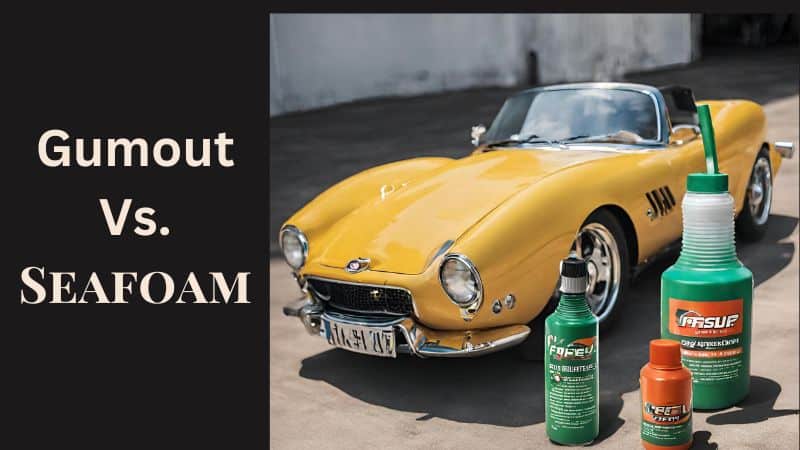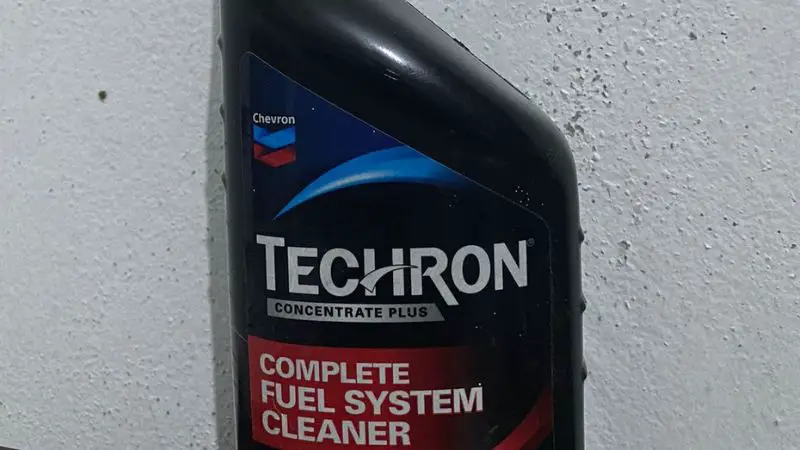When it comes to cleaning your vehicle, you may think of Seafoam vs. Gumout. Actually, they are well-known fuel injector cleaners, each having their own properties. Though they have different properties, people get confused because their primary purpose is the same. But depending on use, they provide additional advantages.
Most drivers only remember fuel injectors if they experienced car engine problems. By that point, you are too late, and your engine damage has been done. That’s why you should use them properly before having any damage. Here, we will tell Seafoam and Gumout features, pros and cons, and more information. After reading their complete properties, you can decide which is better. Have a look:

Gumout Reviews
Gumout is an oxygen sensor-safe fuel cleaner and can improve maximum fuel efficiency and horsepower. It obstructs future carbon buildup and decreases emissions for the environment. This limits any deposition and prevents erosion caused by water or ethanol. You should apply Gumout to your vehicle every 3000 miles driven for maximum engine performance. It also can completely clean the fuel.
Gumout is an excellent cleaner that can help extend the essential engine part’s life. This reduces vibration and increases throttle reaction for quicker response. The engine gets a quick but smooth start without much effort or rush. To get the best result from Gumout, don’t refill your tank until you have used it all, and you should ensure it. Besides this, by using it, you can clean ports and any fuel injectors, pistons, and combustion chambers.
Seafoam Reviews
The Seafoam cleaner will restore the injector spray pattern and clean fuel injectors properly to improve engine performance. Fuel injectors help your engine to perform at its best in terms of performance and power. Additionally, the fuel injector will idle if you don’t clean it regularly.
Seafoam also can help your car get better fuel economy. In addition, it cleans and removes harmful pollutants from the engine. One of the critical properties of Seafoam is that it lubricates during cleaning. So, there is always a coating of varnish on the outer surface that helps the engine clean easily and hassle-free.
Gumout Vs. Seafoam Key Features Comparison
Let’s compare Gumout vs. Seafoam for diesel features to know which products will be best for you. They both come with weak and strong points. Purchasing one over another mightn’t be different because your injector will clean either way.
Increased Gas Mileage
Accordingly, Gumout can increase the airflow. That’s why the oil can flow without much difficulty and does not let the engine starve without its oil. Many guns and deposits are more prone to fuel absorption. Typically, Gumout removes deposits, hydrocarbons, and harmful carbon monoxide to increase gas mileage.
In contrast, Seafoam allows the engine to accelerate better and faster, leading to improved gas mileage. The less effort required to start, stop, or speed up an engine, the more fuel will be. Notably, it’s best for both machine and fuel. The engine gets proper treatment where less energy is used.
Optimizes Fuel Economy
Gumout needs every 3000 miles. Add Gumout to your empty tank. Since the cleaner works against corrosion and prevents pollution, it also improves mileage. Considering the extra mileage, you can save a decent amount of time and money.
One fact follows another. The increased mileage that Seafoam offers results in optimum fuel consumption. Seafoam is a product that is used every 2000 to 5000 miles. So it’s a repeat cycle of purchases, yet it’s worth your money and will pay off in the long run.
Prevent Carbon Buildup
Generally, Gumout can reduce emissions, and it’s proven. Basically, it can fight against ethanol and water corrosion. Even so, it prevents carbon waste from getting stuck along engine and oil line paths. Thus, it obstacles the engine from carbon buildup while protecting the inner walls and upper cylinder.
On the contrary, Seafoam also resists carbon buildup with its coated shield. Moreover, it’s a formulated mixture that prevents debris in your oil tank. Yet, it clears and dissolves all of vanishes and varnishes. It does not let your engine lust when used as directed to keep the overall performance at peak; Rather, it lubricates while doing this.
Limitations
Anything too much can cause danger rather than good. Ergo, Seafoam dilutes the oil if you put too much in your crankcase. If one avoids the instructions and the stated measurements, it will undoubtedly cause damage. Besides, it can remove all the necessary elements, including gunk and waste residue. Eventually, it will shut down your engine when necessary.
Both fuel injector cleaners are excellent, but they also have drawbacks. The residue may block the pickup point when cleaning a large amount of gunk. Therefore, it provides the same results as when the oil is diluted.
Why Compare?
Seafoam and Gumout Fuel Injector Cleaner are both top-rated products. There’s no denying that both have helped huge drivers worldwide keep their cars running smoothly and efficiently. Their essential difference is that Seafoam is a cleaner, and Gamout is a protector. Mainly, the job of Seafoam is to clean your fuel injectors and lines. And Gumout can protect your fuel injectors and lines.
But, like most specialties in life, there is always space for improvement. Both brands have specific advantages and disadvantages when compared to each other. So you should know which one is best for you and your car.
Pros And Cons Of Gumout Vs. Seafoam:
Before choosing any products, knowing their advantages and disadvantages is essential. As another product and things you should know about Gumout and Seafoams pros and cons: Here you get that:
Pros Of Gumout:
- Increase the life of crucial engine parts
- Reduced wear and fiction in the upper cylinder
- Improves horsepower and fuel economy
- Cleans properly indirect and direct fuel injectors
- Improves performance across the fuel system.
Cons Of Gumot:
- Slight reduction in MPG while in use
- Little expensive
Pros of Seafoam:
- Liquid carbon deposits
- Clean the engine
- Stabilize the fuel for up to two years
- Lubricating the upper cylinder
Cons Of Seafoam:
- Possible damage O2 system
- Diluting your oil
- Fuel is not compatible with the engine
Gumout vs. Seafoam: Which One Is Better?
After a head-to-head comparison, we know Seafoam is the better product. But both products perform in different ways. The Gumout line is an oxygen sensor-safe option that purges gunk from your fuel system. Also, Gumout multi-system cleaner will help you to start your car better. However, Seafoam dissolves the gunk, so it is flushed out of your system. Undoubtedly, it also helps improve fuel mileage like Gumout.
In particular, Seafoam is EPA-approved and helps lubricate your fuel system to protect it. Another factor in its favor is that it can stabilize your fuel for up to two years. Most importantly, Seafoam doesn’t hurt any carb parts. Note that the carb has o-rings that can only be removed by pulling the carb off the rack. Nonetheless, both products are essentially the same when discussing cleaning injectors.
To understand which products are best, you need to see the additional benefits they get from ingredients. Ultimately, Seafoam contains more extra ingredients that put it ahead of Gumout. The key to using these products is to follow the directions and not add excess cleaner than you need. They will both dilute your oil if you add too much.
Gumout vs. Techron:
These two brands are on every best-of list we’ve tested. Generally, Chevron’s Techron tops the list, while Gumout is fighting in the middle of the pack on the same list. Since 1941, Gumout has been made and is owned by the ITW Global Brand Company. Chevron owns Techron, one of the world’s largest energy providers.
Techron uses unique Polyether Animate (PEA) material that does a top cleaning job every time you use it. And this property is responsible for making this Techron unique. Adversely, if Gumout has a PEA, it may have licensed that material from Chevron. Primarily, Techron can remove carbon deposits and rust, but Gumout has limitations in removing garnish buildup. Hence, Gumout has a built-in carbon inhibitor, and Techron has excellent corrosion resistance.
Another difference is the price. Without any doubt, Gumout is more expensive than Techron. In fact, Gumout is one of the more costly cleaners you can purchase. Alternatively, Techron is more affordable than Gumout. Although both products are highly effective, tests have shown that Techron is excellent. Consequently, it’s proven that Techron is the best product, with a 66% improvement in fuel economy and a 99% reduction in emissions.

Seafoam Vs Techron:
Techron and Seafoam Cleaner are great at doing what they claim. Before applying injector cleaner, you should understand what you need. You may use a fuel additive if you get erratic RPM, excessive vibration, or roughness while driving. Subsequently, Seafoam takes a while to ignite and work. But when it starts working, it works best.
Chevron Techron contains active chemical ingredients such as hydrotreated light distillate 25-75%, alkyl dithiol thiadiazole mixture, and 0.5-1.5% naphtha solvent. Above all, if you need to use the injector cleaners regularly, you can choose Seafoam. For an old engine and better treatment, Seafoam works well. With high mileage, you will get a smooth start and efficient running. With Seafoam, you can quickly change gears while driving; the engine runs smoothly without hesitation.
On the other hand, Techron chemicals do not damage sensors. This additive is ideal for catalytic converters and any electric hybrid automobiles. Smooth to use with techno fuel and gasoline containing ethanol.
Can You Mix Seafoam And Gumout?
Yes. But don’t do that. After reading other reviews, we saw that no one said you can’t mix them. Similarly, we read the warnings, and one said you can’t mix them. It’s because both can clean your injectors over time and can be used every 3,000 miles. Before filling up your tank, you can put Gumout in your tank. Then, according to your company instructions, add another 21 gallons of fuel.
After you do this, drain the gas tank before refueling and adding more Gumout. At this stage, you can add Seafoam or vice versa. Since both products do the same thing, mixing them should be fine.
FAQ (Frequently Asked Questions)
Q. Is Gumout a good fuel cleaner?
In general, Gumout is an excellent product that works well. Likewise, you can use it in many big Van and smaller engines. The reason is that you won’t experience harmful deposits after a long time of use. Even so, it keeps your Turbo diesel engine clean and protected like a professional cleaner.
Q. Why not use sea foam?
Sea Foam is best for most gas and diesel engine vehicles. Indeed, if your engine has direct injectors, sea foam can clog it. Repairing a stuck engine can be very expensive, especially for diesel direct-injection motors. Unless your machine has direct injectors, it is perfectly safe to use Seafoam.

Final Word
On the other hand, Gumout vs. Seafoam: which one is better you wanted to know. Basically, Many people believe that Gumout has a different ability to produce the same results as Seafoam. Both are the two famous brands on the market and work well to clean the engine. But when discussing limitations, using too much Seafoam can dilute your oil. Likewise, Gumout can build up large amounts of carbon over time. Overall, to get the best result, you should use any cleaner in moderation. Finally, we hope this article will help you choose the best one from Gumout and Seafoam.
Check:
Between Engine Restore Vs. Lucas Oil
